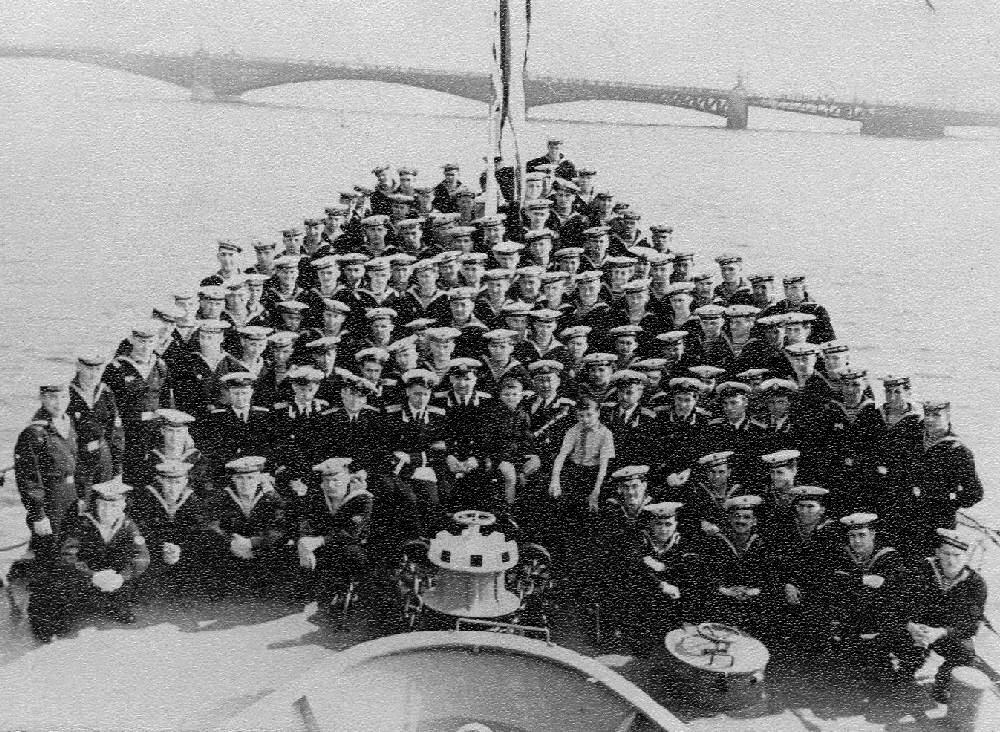
Cold War Military Sector Trends: Naval Balance--Country Trends

Figure 1.--The Soviet Red Navy at the end of World War II were left with a few submarines and some Lend Lease American destroyers. From this base they began building a major naval force. A signicant emphasis was given to submarines, especially with the development of sub-launched balistic missles. The Soivets also built a range of surface ships. This is obviously a small ship, but we can nor see enought to identify it. Our major source on weaponry tells us, "I looked through my entire collection of Soviet/Russian ships and could find nothing with this type of bow configuration. It looks like the photograph was taken from the front of an open bridge but there is no gun turret or gun mount. Pergaps it is a coastal defense ship like a mine sweeper. The bow area in front of the bridge is just way too small for even a destroyer escort (DE) type of ship. (A DE is the smallest type of naval ship.) It loks to have been taken in the late-1950s. The captain and perhaps another officer has brought their sons onboard for a crew portrait. One is wearing his Pioneer uniform. This was less likely in he U.S. Navy or British Royl Nsvy and speaks to the god-like authority of a Soviet naval captain.
|
|
Only two countries maintained large modern navies during the Cold War, the United States and Soviet Union. Ultimately the U.S. Navy suceeded in its primary mission to maintain a creditable defense and the security of its Western European allies. The Soviet Navy not only failed to undermine Western Europe's security, but the cost of building and maintaining the Navy and other military was beyond the capability of the inefficent Communist economy, eventually leading to the implosion of the Soviet Union. The U.S. Navy ended World War II as the largest navy in the world. The U.S. Navy's primary concern at the end of World War II was mothballing and decommisioning and scraping large numbers of ships. Thus was begun at a time in which the world was seen at peace and the Soviet threat not yet ubderstood in the West. Many continued to see the Soviets as a vallint Wiorld war II ally. In addition, many military analysts and budget-concious politicians argued that in the nuclear age, navies were an anachronism. This only changed as the Soviet threat became better understood and the Soviets began a major naval building program. The competition between the two navies became ione of the major and least reported campaigns of the Cold War. The Soviets expanded their Navy, especially after the Cuban missle crisis. By the end of the Cold War the Soviets has a large, higly competent naval, nuclearly armed, forces, but without the carrier battle groups of the U.S. Navy. In the end, a Communist economy was unable to support the massive military forces created by a Communist state. Britain also had a large naval force at the end of World War II. The Cold War was a period of steady decline for the Royal Navy. Both economic and political reasons were involved. This decline meant that that Britain was almost unable to resoond to the Argentine seizure of the Falkands (1982). The American military assessment was that the Royal Navy did not hace the capbility of overcoming Argentine air strength. The Royal Navy acquire Trident nuclear missle submarines which became a political issue. Canada became a major naval power during World War II escorting North Atlantic convoys against the German U-bost threat. Canada primarily was involved in reducing the size of its World War II navy. Other NATO allies (France and Italy) built small navies. We do no not know of ny other NATO or Warsaw Pact country tht has a substantial navy. Sweden improved the capabilities of its navy because of confrontations with the Soviets in the Baltic. Nor did Third World countries build substantial navies. India had the largest Third World navy. China during the Cold War because of the failure of the Communist economy was unablre to build a major navy which is why Taiwan was able to maintain its indeoendence. This changed when the Communist Government asopted market reforms (late-1970s). As a result, China began to lay the foundation for a modern navy (1980s), but at the end of the Cold War (1991), China still did not yet a creditable naval force. Japan resurected its navy, building a small, but echnologically advanced navy for defensive purposes.
CIH -- Cold War

Navigate the CIH Cold War Section:
[Return to Main Cold War naval military balance page]
[Return to Main Cold War military balance page]
[Return to Main Cold War military page]
[Return to Main Cold War page]
[Assessment]
[Biogrphies]
[Countries]
[Communism]
[Culture]
[Decolonization]
[Economics]
[Famines]
[Fashion]
[Freedom]
[Hot wars]
[Human rights]
[Inteligence]
[Mass killing]
[Military]
[Pacifism]
[Phases]
[Science]
[Totalitarianism]
[Bibliographies]
[Contributions]
[FAQs]
[Images]
[Links]
[Registration]
[Tools]
[Return to the Cold war Home page]
[Return to the 20th century wars and crises]
Created: 5:40 PM 9/14/2018
Last updated: 5:41 PM 9/14/2018



